December 15, 2023
Air Date: December 15, 2023
FULL SHOW
SEGMENTS

New FDA Rules for Cosmetics
/ Aynsley O'Neill, Steve Curwood and Victoria St. MartinView the page for this story
A new law updates cosmetics regulations at the Food and Drug Administration for the first time in 85 years. But gaping loopholes remain for ingredient disclosure and safety testing, amid the continued presence of carcinogens, hormone disruptors and other harmful chemicals in cosmetics. Hosts Aynsley O’Neill and Steve Curwood explain the update and its impact with help from Inside Climate News Reporter Victoria St. Martin. (05:06)
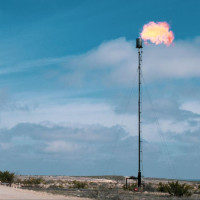
Beyond the Headlines
/ Peter DykstraView the page for this story
This week, Living on Earth Contributor Peter Dykstra joins Host Aynsley O’Neill bringing news of a step towards phasing out natural gas in Massachusetts, and a lost-then-found tomato in space. In history, they mark an anniversary for the U.S. Marine Mammal Protection Act that’s helped conserve seals, whales, and more. (04:09)

Of Time and Turtles with Sy Montgomery
View the page for this story
Author and animal whisperer Sy Montgomery’s latest book, Of Time and Turtles: Mending the World, Shell by Shattered Shell features miraculous stories of recovery at a hospital for gravely injured turtles. Sy joined Host Steve Curwood in the NHPR studios to share these stories and discuss how these long-lived, ancient beings help illuminate the nature of time itself. (20:59)
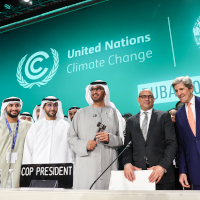
Ending the Fossil Fuel Era
View the page for this story
Nearly 200 nations attending the COP28 UN climate summit in Dubai came to a consensus to declare fossil fuels are on their way out, marking a breakthrough after three decades of climate summits. Alden Meyer, a senior consultant at E3G, joined Host Steve Curwood from Dubai to explain the outcome and what’s needed to turn the words into action. (15:17)
Show Credits and Funders
Show Transcript
231215 Transcript
HOSTS: Steve Curwood, Aynsley O’Neill
GUESTS: Alden Meyer, Sy Montgomery
REPORTERS: Peter Dykstra
[THEME]
CURWOOD: From PRX – this is Living On Earth.
[THEME]
CURWOOD: I’m Steve Curwood.
O’NEILL: And I’m Aynsley O’Neill.
Why there was a breakthrough this year at the UN COP28 climate summit after decades of delays.
MEYER: In the run up to Rio in 1992, it was primarily the science community that was driving this process. Now you have healthcare professionals, you have the faith community, you have labor unions, and most importantly to me, you have the youth coming in and saying “this is our future, you need to leave us a habitable planet.
CURWOOD: Also, Miraculous stories of saving horribly hurt turtles.
MONTGOMERY: Their shells were cracked, eyes were missing, arms were broken, tails were off. You just think, they're a goner. But then, a few years later, some of these horrendous cases were released, healed, into the wild.
CURWOOD: That and more, this week on Living on Earth. Stick Around!
[NEWSBREAK MUSIC: Boards Of Canada “Zoetrope” from “In A Beautiful Place Out In The Country” (Warp Records 2000)]
[THEME]
New FDA Rules for Cosmetics

Nail polish, among other cosmetics, often contains harmful chemicals. (Photo: Lelê Breveglieri, Wikimedia Commons, CC BY 2.0)
O’NEILL: From PRX and the Jennifer and Ted Stanley Studios at the University of Massachusetts, Boston this is Living on Earth. I’m Aynsley O’Neill.
CURWOOD: And I’m Steve Curwood. Later in the broadcast we’ll mark the historic moments at COP28 in Dubai as the world’s nations agree to transition away from fossil fuels. But first, Aynsley you’ve got a cosmetic safety update, right?
O’NEILL: Yeah, Steve, as you know what’s in the cosmetics that millions of Americans use on our skin, hair, and nails every single day is often a big question mark. What we do know is that some of the chemicals found in things like shampoos, deodorants, and lipsticks have been linked to serious health problems, but there’s a huge regulatory gap. Back in 2019 the House Energy and Commerce Subcommittee on Health chaired by Democratic Congresswoman Anna Eshoo of California, held a hearing on this gap.
ESHOO: The only thing standing between Americans and a dangerous cosmetic product is an 80-year-old federal law, the 30 employees at the FDAs office of cosmetics and colors and strongly worded letters from the FDA. To put it bluntly, we don’t know what’s in our cosmetics, and what we don’t know could hurt us.
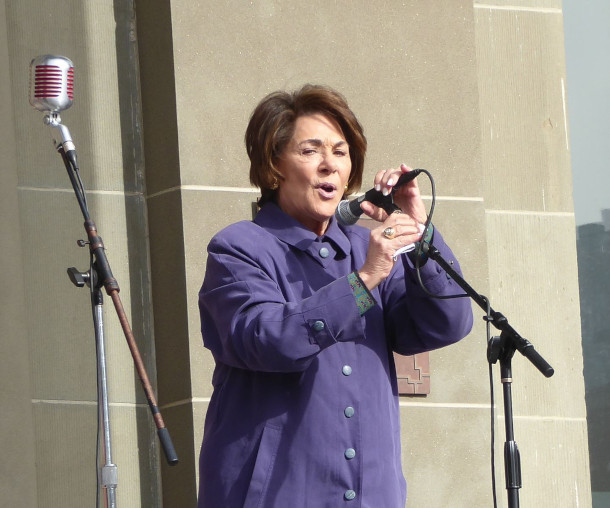
Congresswoman Anna Eshoo chaired a hearing in 2019 that led to the Modernization of Cosmetics Regulation Act. (Photo: Brian Washburn, Wikimedia Commons, CC BY 2.0)
O’NEILL: So, A new law, the Modernization of Cosmetics Regulation Act, goes into effect at the end of this month, and that’ll give the Food and Drug Administration more power to regulate the industry. I spoke with Inside Climate News reporter Victoria St. Martin, who has been reporting on this and walked me through some of the health risks from products containing such toxins as formaldehyde.
ST. MARTIN: It’s linked to cancers - reproductive cancers like uterine cancer, breast cancer, endometrial cancer. Formaldehyde is not only used in chemical hair straighteners and hair smoothers, but it’s also used as a preservative in personal care and cosmetics.
O’NEILL: There are also parabens, which disrupt hormones and harm the reproductive system and even heavy metals including mercury.
ST. MARTIN: It’s in a lot of skin lighteners and it can damage the kidneys and the nervous system.
CURWOOD: Yikes. And we’ve talked with researchers who study the health impacts of endocrine disrupting phthalates in cosmetics. Those are linked to obesity, diabetes, and pre-term birth, among other health problems.
O’NEILL: Right. And Steve, Victoria says the US is really behind some other industrialized countries when it comes to protecting consumers from the harmful chemicals in these products.
MARTIN: In the European Union they ban 2,000 and counting chemicals from cosmetics. In the United States at this moment, 11 chemicals are restricted or banned.
O’NEILL: That’s a disparity reflected in how we regulate chemicals here in the US in general. Instead of a precautionary principle, we wait to see harmful effects from chemicals already on the market, and then we consider banning them. Unfortunately, although these new rules are a good start, they don’t change that basic system. They focus more on disclosure.
CURWOOD: Yeah, you know, we’ve reported on how the word “fragrance” is often used by the cosmetics industry to hide some of these chemicals from ingredient lists by claiming they are proprietary. Things like phthalates. So how might these new rules help rein in that?
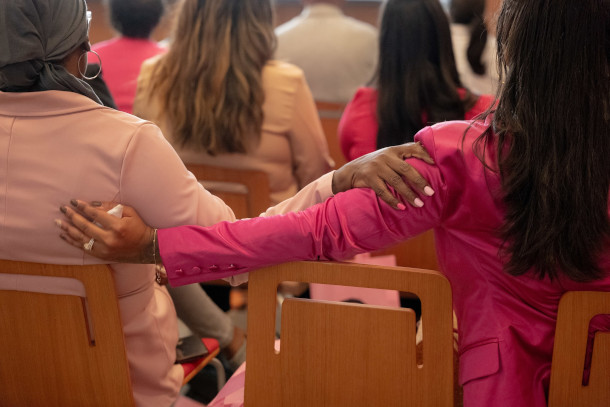
Exposure to harmful chemicals in beauty products, including formaldehyde, increases the risk of developing cancer, including breast cancer. (Photo: Caroline Gutman, Courtesy of Inside Climate News)
O’NEILL: Well, although companies will now need to report to the FDA what chemicals are in that “fragrance,” they will only need to list those chemicals on the label consumers see if the ingredients can cause allergic reactions. So, that doesn’t change all that much in terms of what information is readily available to the public about what’s actually in a product. But the new law does give FDA more authority to recall products when consumers report adverse effects. Another new requirement is that companies will need to conduct safety testing.
But Steve, Victoria St. Martin of ICN points out that there’s a huge catch.
ST. MARTIN: So companies will have to do this safety testing but the FDA won’t be able to make sure it’s happening. So it’s like, I will say that I did my homework, but my mom can’t look at my homework [LAUGHS] and make sure that I actually did it.
CURWOOD: Wow. So how can people be sure these products are safe?
O’NEILL: Well, with significant regulatory gaps remaining, it’s really still up to us consumers to do our homework on whether the products we use are safe. There are resources like the “Skin Deep” cosmetics database from the Environmental Working Group, which lets you type in a product name and learn more about its ingredients if the company has made that information available. And Victoria explained that pressure from the public for safer cosmetics really seems to be leading the charge to make regulatory changes.
ST. MARTIN: I don’t think there’ll be another 85 years with little regulation. I just don’t think that’s ever going to happen anymore. Those days are gone. The more that we push to have safer and cleaner products, not only will our lawmakers answer, but also industry will as well, because if we’re not buying products that we are concerned about, then they won’t make them anymore.
O’NEILL: So maybe someday, the ingredients in the shampoo, moisturizer and deodorant we buy won’t be a mystery.
CURWOOD: That’ll be good to know.
Related links:
- Read the full text of the Modernization of Cosmetics Regulation Act
- Read Victoria St. Martin’s original story on Inside Climate News
- Explore options for safe and eco-friendly personal care products
[MUSIC: Christian Seldelmyer, “Pushin’ Through” on Ravine Palace, Christian Seldelmyer/Tasty Note Records]
Beyond the Headlines
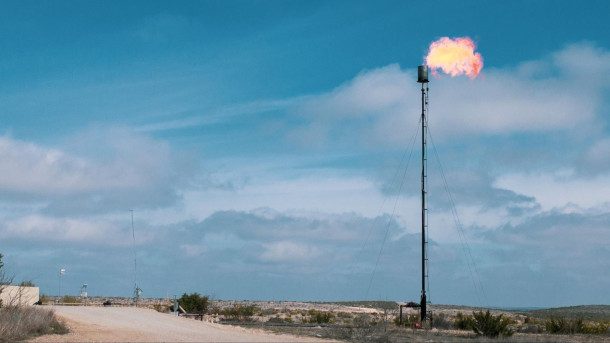
A new ruling from the Massachusetts Department of Public Utilities aims to hasten the phase out of natural gas in the state. (Photo: Jonathan Cutrer, Flickr, CC BY 2.0)
O'NEILL: It's time now for a look beyond the headlines with Peter Dykstra, the Living on Earth contributor who joins us from Atlanta, Georgia. Hey there, Peter, what do you have for us this week?
DYKSTRA: Well, hi, Aynsley, we'll start out with a potential good news story for clean energy from the home and birthplace of Living on Earth, the Commonwealth of Massachusetts. The state just took a big step toward moving away from natural gas as a heating and power source. The Massachusetts Department of Public Utilities has ruled in favor of hydrogen as a future source of heat and power, and also other clean energy modes like solar and wind power. The gas industry was quite upset about this. Natural gas, of course, is a fossil fuel and a climate change contributor. Massachusetts is the first of quite a few states that may take that path.
O'NEILL: Well, yeah, I think Massachusetts residents should feel pretty proud that they're, you know, leading the charge in that way. So Peter, what else do you have for us this week?
DYKSTRA: We've got a mystery from space that's possibly solved. The International Space Station grew some small tomatoes, as part of a first step experiment for how long missions in space, like a potential trip to Mars, could grow at least some of their own food, and one of the tomatoes went missing.
O'NEILL: It went missing, Peter? Are we sure it didn't just get eaten?
DYKSTRA: Well, that was one of the theories. One of the American space station astronauts, a man named Frank Rubio, set aside the tomato in a plastic bag so he could show it to school kids who had wired into the space station and wanted to see evidence of a tomato grown in space, and he thought he velcroed it to a place where he could easily find it. Then he said the tomato disappeared. So the mystery was partly solved months later, after Frank Rubio was back on Earth. NASA revealed that the tomato has been found. They didn't really give any details. But Frank Rubio is cleared of losing the tomato, hiding the tomato, or eating the tomato, thus closes the potential conspiracy.
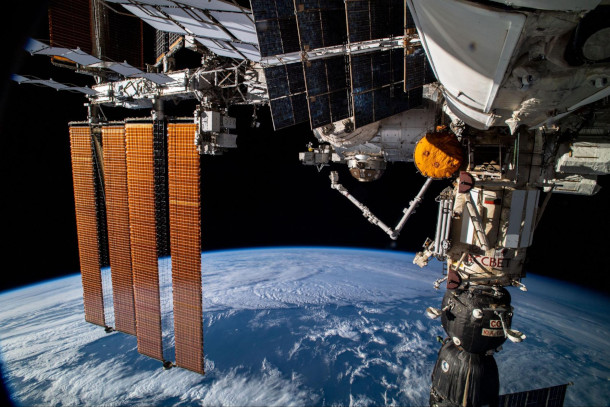
A misplaced tomato grown in space was recently found, NASA revealed. (Photo: NASA Johnson, Flickr, CC BY-NC-ND 2.0)
O'NEILL: Well, good to know we've got one mystery solved and a potential conspiracy theory got nipped in the bud. And Peter, what do you have for us from the history books this week?
DYKSTRA: December 21, 1972, the US Marine Mammal Protection Act takes effect, one of several landmark laws that took effect during the administration of that old tree hugger Richard M. Nixon. It put strong limits on the taking of seals and sea lions, and it outlawed virtually any and all commercial whaling. The last whaling station in the US had closed that same year, 1972. And I'll bet you can't tell me where.
O'NEILL: I mean, my best guess would have to be Alaska?
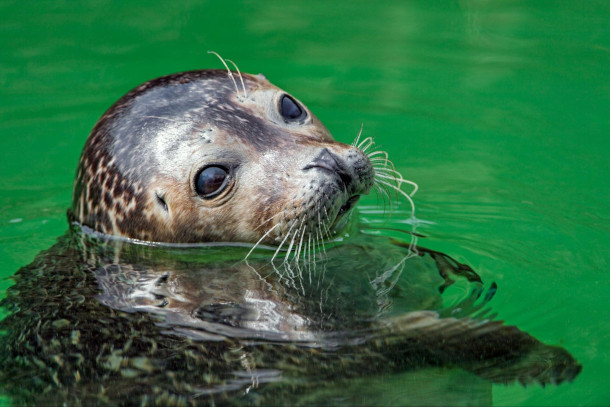
The Marine Mammal Protection Act, enacted in 1972, protects creatures like seals, dolphins, and whales (Photo: Tambako the Jaguar, Flickr, CC BY-ND 2.0)
DYKSTRA: Alaska is a decent guess, but it's not the right guess. The San Francisco Bay area specifically, the industrial city of Richmond, California, shut down its whaling station in 1972. Alaska Natives are still allowed to conduct a traditional hunt for bowhead whales that have been a part of their tradition and their reliance on food source since time immemorial.
O'NEILL: Thanks again for another look beyond the headlines, Peter. Peter Dykstra is our Living on Earth contributor, and we'll talk to you again in the New Year.
DYKSTRA: In the new year. This is my last one for 2023, and I want to thank everybody for listening and wish you Happy Holidays and a Happy New Year.
O'NEILL: You can find out more on these stories on the Living on Earth website. That's loe.org.
Related links:
- Inside Climate News | “Massachusetts Just Took a Big Step Away from Natural Gas”
- The New York Times | “Space Station to Earth: Houston, We Have Found the Tomato”
- Learn More about the Marine Mammal Protection Act
[MUSIC: Greg Porée, “My Favorite Things” on Phoenix, Moontraxx]
O’NEILL: Coming up, healing injured turtles and mending the world, shell by shattered shell. That’s just ahead. Stay tuned to Living on Earth.
ANNOUNCER: Support for Living on Earth comes from Sailors for the Sea and Oceana. Helping boaters race clean, sail green and protect the seas they love. More information @sailorsforthesea.org.
[CUTAWAY MUSIC: Greg Porée, “My Favorite Things” on Phoenix, Moontraxx]
Of Time and Turtles with Sy Montgomery

The cover of Of Time and Turtles: Mending the World, Shell by Shattered Shell by Sy Montgomery, with illustrations by Matt Patterson. (Photo Courtesy of HarperCollins, Illustration by © Matt Patterson)
O’NEILL: It’s Living on Earth, I’m Aynsley O’Neill
CURWOOD: And I’m Steve Curwood.
[MUSIC: Ziggy, “No More Words” on Finger Picked Poems, Artist Original]
CURWOOD: With me now is Sy Montgomery. Her latest book is called, Of Time and Turtles: Mending the World, Shell by Shattered Shell. Welcome back to Living on Earth, Sy!
MONTGOMERY: Oh, I'm so pleased to be here with you.
CURWOOD: This is an amazing book, and I have to tell people who can't see the cover, that it has, I think this is a painted turtle on the cover?
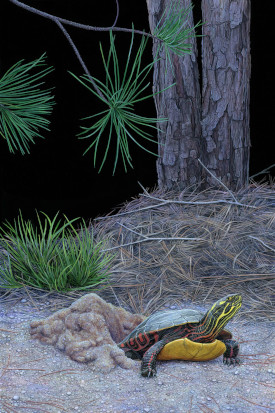
“Eastern Painted Nesting.” (Illustration by © Matt Patterson)
MONTGOMERY: It is.
CURWOOD: But the painted turtle's shell, has well kind of like a bandaid across it, because it's cracked. And it's a beautiful turtle, by the way, great colors, there's yellow, there's red, there's black, illustrated by your illustrator, right, Matt Patterson?
MONTGOMERY: Matt Patterson, who's also a major character in the book, and a real turtle savant.
CURWOOD: So, Sy, you've written so many books about many different kinds of creatures. In fact, upon your advice, I've gone looking for pink dolphins in the Amazon. I've spent some time with an octopus, Octavia. She was quite lovely.
MONTGOMERY: Oh, yes, she liked you.
CURWOOD: And then I've also learned about hawks, to my surprise. But for this book, what ignited your desire to spend time with turtles and write about them? I mean, tell us that story, please.

Matt Patterson and Sy Montgomery enjoy a cuddle with Fire Chief the snapping turtle. (Photo: Jeanne Urda)
MONTGOMERY: Well, I've always loved turtles. But it wasn't until about seven years ago when I met Matt Patterson that I started getting deeply into turtles. And Matt, as I said, is a real turtle aficionado. He considers himself a turtle artist. And we started doing "turtle-y" things together. Well, around this time, I had finished "The Soul of an Octopus," and was thinking about what would be my next big project that I would pour years of my life into? Well, having explored the philosophical question of consciousness in, "The Soul of an Octopus," for my next big book, I wanted to explore the philosophical question of time. Time is a mystery, just like consciousness. We wonder, you know, what is it? Is it real? Does it flow through us? Do we flow through it? What do we do with it? Who has it? And who better than turtles to help me understand time, these ancient creatures who evolved at the same time as the dinosaurs, who have great long lifespans, who have wisdom and who understand waiting. And little did I know that I would conduct this inquiry into the nature of time during the pandemic, when time stopped.
CURWOOD: Boy, it did, didn't it?
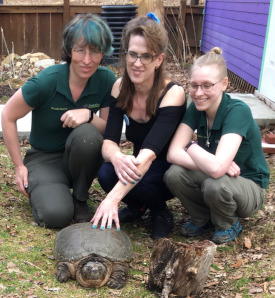
(Left to right) Natasha Nowick, Alexxia Bell, and Michaela Conder spend time with Bonaparte. (Photo: Sy Montgomery)
MONTGOMERY: Yeah. But it was a great time to know turtles, because turtles know ancient time, sacred time. They know the kind of time that isn't ruled by the calendar and the clock. In general, they don't hurry, they don't feel the sort of Damocles over their heads for deadlines. They get everything done when it needs to be done. And they drew me into a wholly different kind of time, the kind of time the Greeks called, "kairos," or sacred time. And you just cannot be with a turtle without feeling you're apprenticed to someone really wise. The oldest turtle on record that we know of only recently died at 288 years of age. So basically, you know, they don't seem to age. In fact, I think they kind of reverse age, because their shells tend to get smoother as they get older. And I don't know about you, but I'm not getting any smoother as I get older!
CURWOOD: It's radio, you can't see the wrinkles.
MONTGOMERY: [LAUGH]
CURWOOD: But this, this turtle that died at 288 years, let me do the math. The United States of America is only 250 or so years old. So this turtle was alive back when-

“Male Wood Turtle.” (Illustration by © Matt Patterson)
MONTGOMERY: When George Washington was roaming the earth. Yes.
CURWOOD: Interesting.
MONTGOMERY: They have so many ways of cheating death, you know. They have that wonderful shell, they can slow their bodies down to brumate or hibernate. They can breathe through their cloaca, they can breathe out of their butts if they need to do it, totally stopping their lungs. They have all kinds of superpowers.
CURWOOD: So you get into this volunteering at the Turtle Rescue League in Massachusetts, to help rehabbing, rehabilitating turtles. Paint a picture for us of what this place is like. You walk in, and you smell and you see what?
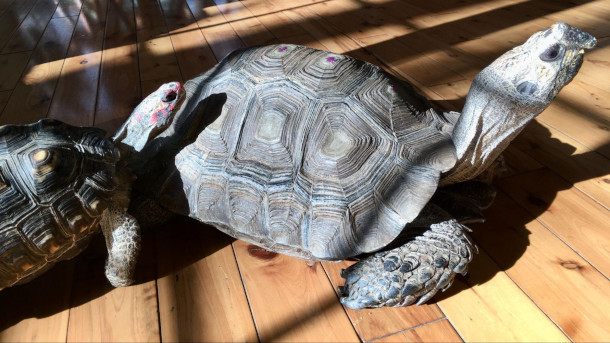
Pizza Man and Sprockets greet visitors at Turtle Rescue League. (Photo: Sy Montgomery)
MONTGOMERY: Wow. Well, the first thing that happens is that you notice it's unlike the other houses on the street, because it's this bright limey green, otherwise somewhat unremarkable, except parked in the front are two turtle ambulances complete with strobe light, and they say "Turtle Rescue League" on the back. So you knock on the door, and Alexxia Bell or Natasha Nowick will answer. The first time we went, we step over a knee high barricade. And what's that for? Well, we soon see the reason for the barricade, because this tortoise named Pizza Man is coming towards us, stomping towards us like a slow motion missile. He wants to be wherever the action is. And he came over, stood at my feet, looked in my face, and performed what was clearly a greeting. He whipped his head to the side, and then whipped it back to me, and then to the side, and then back, staring up into my face. And obviously, it was just like shaking someone's hand or giving someone a hug. And so, Sprockets and Pizza Man, Sprockets is another tortoise, even larger than Pizza Man, they pretty much have the run of the living room and kitchen. But downstairs in the basement is the turtle hospital, where somewhere between, depending on the time of year and how busy it is, 150, 250 maybe as many as a 1000 injured, hatchling, or abandoned turtles are kept in that hospital. And it kind of smells like a warm pond in the summer. And you hear the sound of water pumps, some of the turtles live in water, some of them don't. And they're all different species, some are exotic, some are natives. And everywhere you go, there is a turtle or a tortoise, who is recovering from something, either being abandoned, or having been hit by a car, or chewed by a dog, or hit by a lawn mower. Turtles come in there with some of the most horrendous injuries, you would think they were not survivable. But the first time Matt and I visited, we came away feeling as if we had been to Lourdes, because we saw slides of turtles who had come in, it was as if their organs had been smeared on the road, their shells were cracked, the eyes were missing, arms were broken, tails were off. You just think, they're a goner. But then, a few years later, their shells can heal. You need expert care and you need time. But some of these horrendous cases were released, healed, into the wild. And we had no idea that we'd be experiencing this during the pandemic. But it was just great to be not just witnessing, but actually part of these success stories, these fabulous happy stories of restoration and renewal, during that dark time.

A painted turtle gets a patch for his broken plastron at Turtle Rescue League. (Photo: Sy Montgomery)
CURWOOD: The stories that you have of the healing of these turtles from, as you say, so many horrific injuries, it's more than miraculous. It's literally amazing.
MONTGOMERY: Yeah.
CURWOOD: And in the process, you learn yourself how you can help a turtle, because I think at one point you wind up with a baby turtle that, for all intents and purposes, looks dead. But then what do you do?
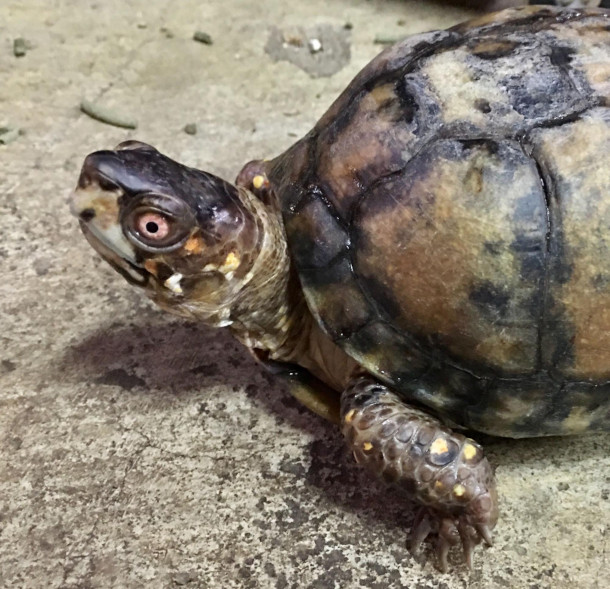
Percy is a centenarian box turtle who lives at Turtle Rescue League. (Photo: Sy Montgomery)
MONTGOMERY: Oh man. Well, on top of assisting Natasha and Alexxia at the hospital, we also raised, with a permit, baby turtles for release into the wild. And I had four baby painted turtles who I was raising up so that they would be a little bit larger than they otherwise would be and kind of have a head start. So these were painted turtles, so they were named Monet, Manet, Bernard and Seurat. So every morning I would turn on the heat lamp for them, make the sun rise, and see my baby turtles, and feed them. And one morning in February, I turned on the light and I only saw three of them. And Monet was like, missing. And freakishly, I discovered him in the detached sucker that held the floating dock to the side of the tank. And he had drowned. He was dead. His eyes were closed, and his neck was limp, and there was no sign that he was breathing. And since this was morning, he could have been there all night. But I remembered about turtle CPR. And this does not involve mouth to beak contact. You move their little arms and legs back and forth and back and forth. And what you're trying to do is start their heart and get their lungs pumping again. So, nothing was happening for the first minute or 10 minutes, or 15 or 30. But after 45 minutes, I saw his neck move. And he came back to life. And that spring, I was able to release him with his brethren. And in that way, a miracle happened in my hand, in our house.
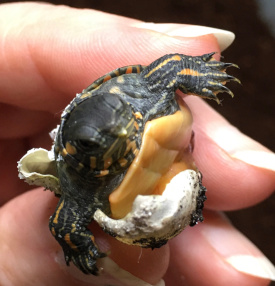
A hatchling painted turtle emerges from its egg. (Photo: Matt Patterson)
CURWOOD: And so now you are a turtle master.
MONTGOMERY: I don't think so! But anyone can do this. We can all be turtle heroes. And not only is it not difficult to bring a turtle back to life in this way. But when you cross a turtle, you're saving a life. And goodness. I mean, anytime you save any little animal, it's a wonderful thing to do. But turtles, most people don't realize, that they are the most endangered kind of vertebrate, there's over 350 kinds of turtles, but as a group, turtles are more endangered than any other creature with a backbone that lives on land in the entire world.
CURWOOD: Why is that?

This snapping turtle was named Robin Hood after he came in with an arrow through his neck. (Photo: Sy Montgomery)
MONTGOMERY: There's so many things against them. They are having all the problems everyone else is having. You know, habitat destruction, and roads, and climate disruption. With turtles climate disruption is particularly bad because sea turtles, the seven kinds of sea turtles, their entire beach might not be there anymore. Many turtles, not just sea turtles, but many turtles, the temperature of the nest determines the sex of the babies, not their genes. So if the temperature goes up a little bit, you're gonna get like, all females. And if it goes up a little more, you get boiled eggs. But on top of all of that, which is bad enough, there's this insidious trade, illegal trade, in turtles, for their meat, for their shells, and for pets. And they are really targeted. So they are vanishing fast. And over 61% of the existing turtle species in the world are endangered or threatened, and many of them are already extinct in the wild.
CURWOOD: So talk to me about the personalities of these turtles. On your book jacket, there's a picture of you and your Illustrator, Matt, and Fire Chief.
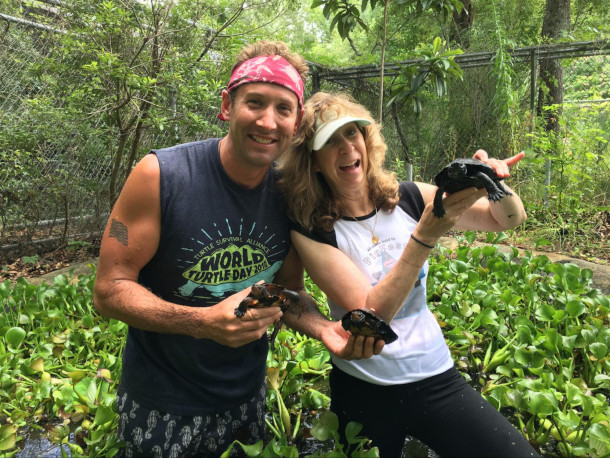
Matt and Sy spend time in a turtle pond at the Turtle Survival Alliance’s Turtle Survival Center in South Carolina. (Photo: Turtle Survival Alliance)
MONTGOMERY: Yes. Well, next time you're in Hancock, we got to introduce you to Fire Chief. He's really awesome. He is a 42 pound, adult male snapping turtle who is probably about my age. I'm 65. And we met him at Turtle Rescue League. He had been there for several years. So the first time I saw him, he was living in the hospital tank and Natasha opened up the lid to the tank and dropped in a banana. And I was amazed to see this huge head that looked like it was as big as my thigh, it wasn't, but this huge head come lurching out, like an estuarine crocodile, you know, eating a wildebeest in the crossing. So he was, he murdered that banana. And I thought man, this turtle, he is magnificent, but he's a little scary. Matt said, he has a wild appeal, because Matt is used to picking up giant snapping turtles all the time. So in 2018, he'd been hit by a car when he was crossing the road, from his summer pond to his winter pond. And his shell had been cracked, and it broke his spine. And his back legs and tail were paralyzed. But they can regenerate nerve tissue. So Natasha and Alexxia fixed him right up. And he was living in a hospital tank. And when Matt and I started volunteering there, one of our happiest tasks was, we were going to do physical therapy with a giant snapping turtle. So the first time we took him out for physical therapy, he's walking around outside for the first time since his accident, and his legs were really weak and our job was to help strengthen them. But what was so amazing was that very first time that we had him out, at one point we put him back down and just were sitting there with him. And Matt and I at the exact same moment, felt this urge to reach out and pet his head. And Alexxia and Natasha were kind of astounded and they thought, did you tell them they could do that? No. Did you tell them they could do that? And when we found out they were saying that to each other, we said, well, no, he told us we could do it. We just felt that he trusted us. And he did. And Fire Chief became a very good friend of ours. He is really gentle. He's not just a gentle snapper. He's a gentle animal. He's a real sweetheart. He's curious. He's focused. He's active. He's brave. And he's kind.
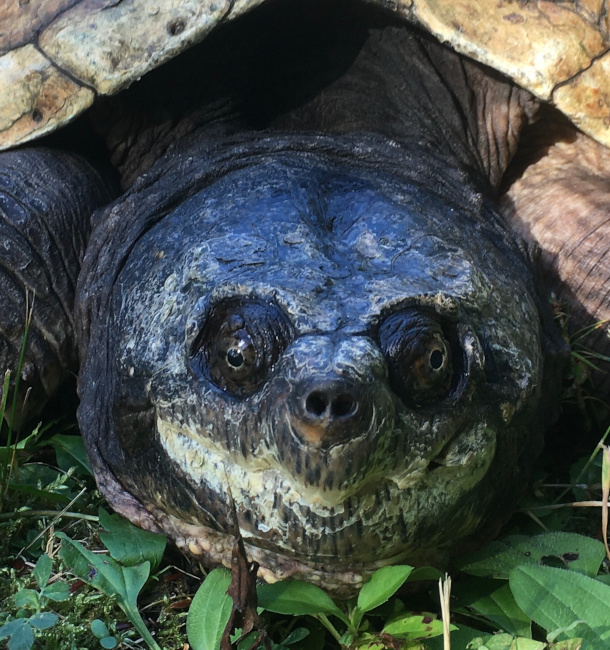
Fire Chief is a 42 pound snapping turtle. (Photo: Sy Montgomery)
CURWOOD: Great attributes. And by the way, how did he get that name, Fire Chief?
MONTGOMERY: Well, he used to live in a pond next to a fire station. And all the firemen knew him. But when he got hurt, the firemen loved him, you know they saw him every year. But these brave guys who run into the burning building to save you, they weren't brave enough to pick up a scary 42 pound snapping turtle. So they call these two skinny ladies, Natasha and Alexxia. And Natasha, by the way, is blind. And they come rushing out with the ambulance and with their kayak. They launch the kayak, Natasha stays in the kayak to receive the turtle, Alexxia jumps into the water and picks this guy up, who, of course, was not in a very good mood, because he just had a horrible accident. And they took him away just fine. So we still call him Fire Chief.
CURWOOD: So what was it like being with these turtles through the pandemic? I think at one point in your book, you describe getting on an airplane to go see turtles and you look around the plane, there's nobody there, because...

Alexxia sets Chutney free after his long rehabilitation. (Photo: Sy Montgomery)
MONTGOMERY: Yeah, this was the very beginning, before we knew of the emergency. We'd heard of some strange contagion that happened in China, but we didn't really think it was going to be a pandemic. And one of my first thoughts was like, oh, my gosh, am I still going to be able to carry out, you know, our volunteer work, but it seems natural to mask in a hospital. And a lot of our work happened outside. So that was just fine. But what was so helpful and healing to me and Matt, I think, was that during this time that it just felt like the whole world was broken into pieces, and it was not just the pandemic, there was, you know, all this, like, racial violence, and this terrible, catastrophic climate change was upon us. The world was on fire. Brazil was on fire, Australia was on fire, our forests were on fire, floods, it really felt like end times. But we had this job literally putting back together broken creatures. And when you're doing something, to mend to the world at a time the world feels broken, that is the way out. And being with creatures who are so strong, and who take the long view, being in the company of turtles, and watching and helping them heal, that was tremendously healing for us. On Election Day, which turned out to not be one day but three, as you remember, Matt and I were driving in, listening to the radio, we were so frustrated, we would just scream in the car. Well, we pulled up to the Turtle Rescue League, put on our masks, went down, started working with turtles, and we spent time with the Fire Chief. And the turtles just reconnected us to another reality. A reality that was gonna be there, no matter who won the election. No matter who won the election, no matter what was going on in our cities and streets, we could help this turtle. And because of that, our souls were mending, too.
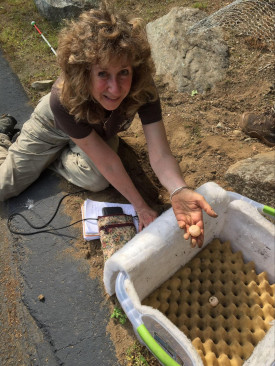
Sy rescues snapper eggs laid by the side of a parking lot. (Photo: Matt Patterson)
CURWOOD: There's a place on page 262, if you could read from, Sy. It's about time, and more.
MONTGOMERY: "In North America's Haudenosaunee, Lenape, and Abenaki creation stories, the Great Spirit creates the homeland by placing Earth on the back of a huge turtle. Many now still refer to North America as Turtle Island. And indeed, this is the continent boasting the most turtle species in the world. In China, the World Turtle is named Ao; the creator goddess uses Ao's legs to prop up the heavens. Without the turtle, we are told, the very sky would fall. Turtle wisdom reminds us that even at a moment in history that feels like the end times, we can find a way to regain our connection with creation--and like the World Turtle, take our turn upholding the earth. If we've used our time wisely, when we are ready, we can at last hand that joyous, terrible, honorable essential burden to the next generation, and the next, and the next, in a great cycle of renewal."
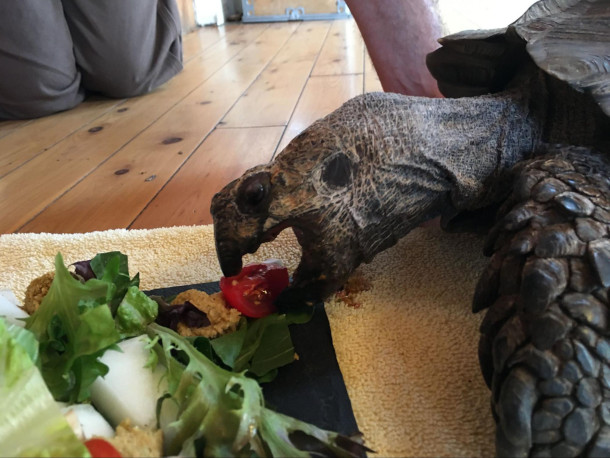
Sprockets, a Burmese Mountain tortoise, enjoys a tomato. (Photo: Sy Montgomery)
CURWOOD: Sy Montgomery's book is called, Of Time and Turtles: Mending the World, Shell by Shattered Shell. Sy, thanks for taking this time with us today.
MONTGOMERY: Nothing I'd rather be doing.
Related links:
- Buy Of Time and Turtles: Mending the World, Shell by Shattered Shell (Affiliate link helps donate to LOE and local indie bookstores)
- Matt Patterson’s Art
- Turtle Rescue League
- Turtle Survival Alliance
- “The Hawk’s Way” LoE Interview
- “How to Be a Good Creature” LoE Interview
- “The Good Good Pig” LoE Interview
[MUSIC: Ziggy, “No More Words” on Finger Picked Poems, Artist Original]
CURWOOD: Just ahead, the promising outcome from this year’s climate summit despite a rocky start. Keep listening to Living on Earth.
ANNOUNCER: Support for Living on Earth comes from Friends of Smeagull the Seagull and Smeagull’s Guide to Wildlife. It’s all about the wildlife right next door to you! That’s Smeagull, S - M - E - A - G - U - L - L, SmeagullGuide.org.
[CUTAWAY MUSIC: Wynton Marsalis, “Winter Wonderland” on Crescent City Christmas Card, Sony Music Entertainment]
Ending the Fossil Fuel Era

Delegates at COP28 finalized language around a “transition away” from fossil fuels in the morning of December 13, 2023. (Photo: Mahmoud Khaled, COP28, UN Climate Change, Flickr, CC BY-NC-SA 2.0)
O’NEILL: It’s Living on Earth, I’m Aynsley O’Neill
CURWOOD: And I’m Steve Curwood.
For days the recent UN Climate Summit in Dubai courted deadlock. This 28th conference of the parties could not move forward unless all of the nearly 200 nations attending agreed on a course of action. And with some demanding a complete phase out of fossil fuels including oil and gas, while others sought to block or slow down such changes it seemed there was little room for compromise. But in the end the rising number of catastrophes linked to climate disruption made it hard to deny the problems, and the risks of doing nothing. So, with nuanced words agreed to by all during overtime negotiations COP28 declared fossil fuels are indeed on their way out. Exactly how and when will be determined at future COPs, with climate advocates looking to the 2025 summit in Brazil to set rules in keeping with the 2015 Paris Climate Agreement. Alden Meyer is a climate advocate and senior consultant at E3G, and we called him up in Dubai shortly after COP28 wrapped up. Welcome back to Living on Earth, Alden!
MEYER: Thanks, Steve, it's always good to be with you.
CURWOOD: What was your reaction to the final text that was hashed out after the all night sessions?
MEYER: Well, I think overall, it clearly wasn't everything we want. We wanted something closer to the text that was tabled four days before the COP ended, which called for the phase out of fossil fuels. This one does not, it calls for a transition away from fossil fuels in the energy sector. It calls for tripling renewable energy capacity by 2030, doubling the rate of energy efficiency improvements by 2030. And it has some potential loopholes such as a clause that talks about the need for transition fuels. And people read that to mean natural gas. So it's not perfect, but it's a lot better than we've had before out of this process. Just to put it in context, until COP26 in Glasgow two years ago, there was not a mention of the need to phase down, phase out, transition away from fossil fuels in the UNFCCC process. Now in Glasgow, we got the language calling for the phase down of unabated coal emissions from the power sector. That's the first time that we got any real commitment to move away from fossil fuels. This sort of raises the stakes there because it expands it to oil and gas. And it dominated these talks for two weeks. It was the center of attention. Everyone was saying this was the key litmus test for how serious this process was. Was it gonna say something about the need to get off of fossil fuels? And well, it's definitely not perfect, and not everything we want. And it was a bit of a sausage-making process to get here, it does signal to the world that the transition away from fossil fuels is accelerating. And that's a good thing.

A group of dignitaries at the 2023 United Nations Climate Change Conference. (Photo: Fotografía oficial de la Presidencia de Colombia, Flickr, public domain)
CURWOOD: Alden, overall, would you say the COP28 created a breakthrough moment?
MEYER: I think it's a breakthrough in the sense that for the first time, you've got the countries of the world agreeing that we need to accelerate the transition away from fossil fuels, to a clean energy economy based on renewable energy, energy efficiency, and other technologies. So that's historic. Of course, it's not specifying the rate of change, or the scale of change, or the pace of change. So it was not just the Saudis, there were countries like the US and others that would not have accepted specific targets for when we're going to reduce production and consumption of oil and gas by x percent. That was just never in the cards. But it does say that by mid-century, we need to be on track to get to net zero emissions as a planet. That could involve some countries like India and China taking a little bit longer. And maybe some countries like the US having to do that a little bit faster. But we need to get there. And to get there, you have to phase down fossil fuel consumption pretty radically and pretty soon. You can't wait until 2045 or 2049, you've got to start doing it right away. It does call for all countries in their next round of pledges under Paris, encourages them to put forward economy-wide pledges covering all greenhouse gasses. Of course, China agreed to do that in the Sunnylands Statement about a month ago with Secretary Kerry. And that's a big deal, because I've been told that China's non-CO2 emissions - its methane, nitrous oxide, and other greenhouse gasses - if taken separately from CO2 would represent the third largest country in the world, just behind China and the US, in terms of emissions. We also have language in here calling for transforming the global financial system to mobilize much greater sums of both private and public sector finance, both to decarbonize developing country paths and to help scale up investments in resilience and adaptation, to cope with the impacts of climate change that are coming at us. Now, there's not enough in there in terms of the specifics, and most of the action on that front is not going to happen. In the UNFCCC, it's going to happen in places like next year's G20 meetings in Brazil. So there's a lot of good things in here. Not everything we want. There's a lot more work to do, particularly to translate this into action in the real world.
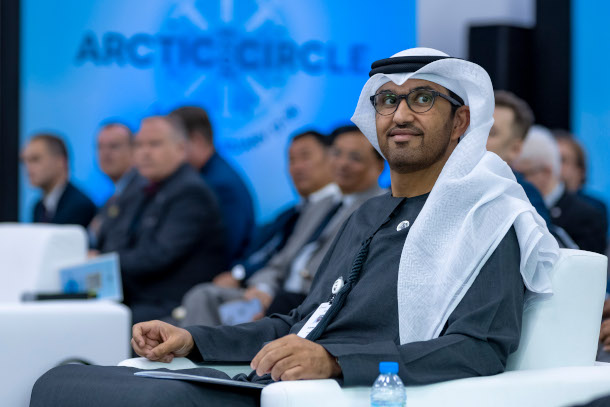
Sultan Al Jaber, the COP28 President, is also CEO of the state-owned oil company Abu Dhabi National Oil Company, or ADNOC. His appointment as COP28 President raised concerns in the environmental community. (Photo: Arctic Circle, Flickr, CC BY 2.0)
CURWOOD: So, how can we measure the success of this in the years going ahead, Alden?
MEYER: As we've discussed before, Steve, the atmosphere only cares about one thing: emissions. It's a matter of physics. It doesn't care what ministers or leaders say in declarations or treaties or pledges or action announcements. It's the bottom line, how much carbon, how much methane, how much nitrous oxide are you emitting to the atmosphere? So the acid test for this is going to come in the next couple of years. Will we see countries put dramatically more ambitious national pledges on the table in 2025 in the second round of Paris commitments? Will we see countries like China, rolling back construction of new coal plants and putting a plan on the table to reduce coal emissions in the second half of this decade? Will we see the US reconsidering expanding production and export of liquefied natural gas, which with the methane emissions incorporated is a bad way to go. Will we see the host country of these talks, the UAE rethink its plans to invest $150 billion in expanding oil production from 3 to 5 million barrels a day? Those are gonna be the kind of tests in the real world that will see whether this is serious, and countries are going to back up the talk with their walk.
CURWOOD: There’s a lot of criticism of the chap who was President of this, Sultan Al Jaber from the UAE, head of an oil company. And John Kerry, the US Special Climate Envoy really reached out to kind of put his arms around him metaphorically and say, no, this is a good guy, we can work with this guy. How important was that relationship, do you think, between John Kerry and Al Jaber in terms of getting a reasonably positive outcome in Dubai?
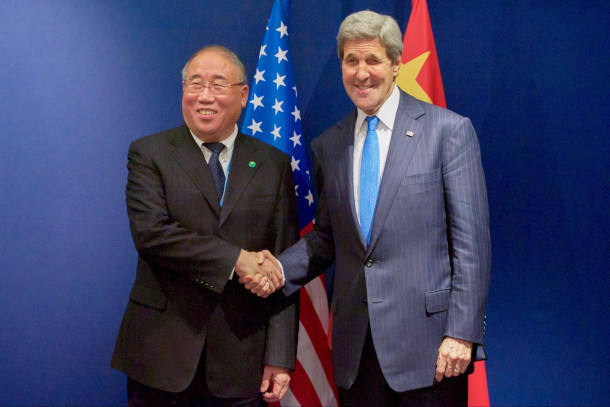
China’s Special Envoy for Climate Change Xie Zhenhua and US Special Envoy on Climate John Kerry released the Sunnylands Statement on November 14, 2023, promoting US-China cooperation on climate. They are pictured here in 2015. (Photo: US Department of State, Flickr, Public Domain)
MEYER: Well, I think it was a very important relationship. I would also say that John Kerry's relationship with Minister Xie from China was very important because they delivered a month in advance of the COP, the so-called Sunnylands Statement, which made some progress in China committing to take on economy-wide commitments to bring methane into the picture. And to try to decarbonize the power sector. And Secretary Kerry and Minister Xie worked very closely over the course of these two weeks, they were both in close communication with Dr. Al Jaber and the rest of the presidency team. So I think that was an important relationship. I mean, you have to judge him by the results, right? And, you know, I think there was a lot of skepticism that he would be able to pull this off, that he was too close to the oil countries and the oil and gas industry. Now maybe that actually worked to his advantage, because they knew him. They trusted him, they had a relationship with him. I've met him only a few times, he's a very sharp guy, very knowledgeable, has been in this space for 15 years, knows a lot of the players. I was skeptical he was going to be able to pull this off, frankly. But it could be that that expression of skepticism and the concerns about a potential conflict of interest in his role as COP President and his role as CEO of the Abu Dhabi National Oil Company lit a fire under him. And he said, okay, I'm gonna prove the skeptics wrong. And maybe that was a motivating factor to him. I don't know, I'm not a psychologist, and I don't know him closely enough to get into his head. But I could imagine that that would be a motivational factor to prove the skeptics and the doubters wrong.
CURWOOD: Now, let's talk a bit about money world wide. How does what is being sought in the agreement struck in Dubai, compare to the subsidies to the fossil fuel business around the world?
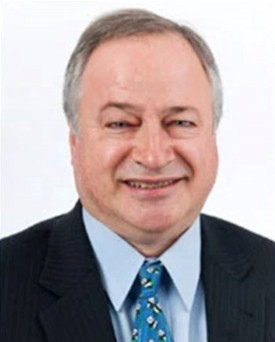
Alden Meyer is a Senior Associate at E3G working on US and international climate policy and politics. He is a Principal at Performance Partners, which provides a range of consulting services to clients in government, business, and the non-profit sector. (Photo: Courtesy of Alden Meyer)
MEYER: Well, just to put it in one comparison, the first day of the COP, we had a decision to operationalize the loss and damage fund that was called for in last year's COP in Sharm el-Sheikh, Egypt. They adopted that. And very soon thereafter, they assembled a little over $700 million in pledges from a number of countries to provide some seed funding for that fund to get up and running. Just to put that in perspective, we spend about three and a half billion dollars a day subsidizing people to produce and consume fossil fuels. Almost a trillion and a half dollars a year. So that 700 million represents about four or five hours of fossil fuel subsidy spending. And when you think about it, it's insanity. We're actually paying people to produce and burn something that we say is an existential threat to humanity, and is going to make the need for loss and damage funding much, much greater. It makes no sense. I was in Pittsburgh in 2009 when President Obama convinced other G20 country leaders to commit to phase out fossil fuel subsidies in the medium term, as they said. I think you can make an argument that 14 years later is the medium term. And far too few countries have actually followed through on that. Matter of fact, the International Monetary Fund says that fossil fuels subsidies have been increasing in recent years, not cut back. So that's literally the definition of insanity: digging the hole deeper and paying people to do something that you say you don't want.
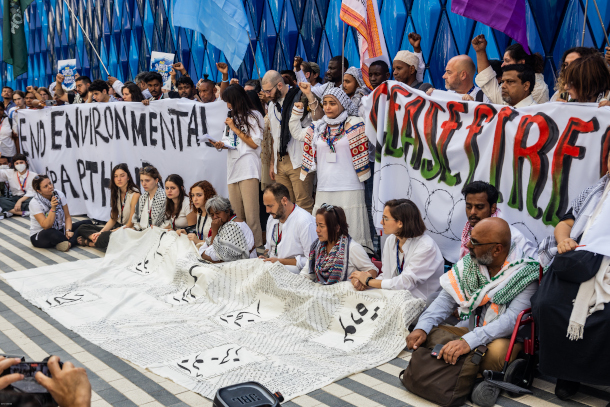
At COP28, some activists and delegates also expressed environmental concerns about the war in Gaza and called for a ceasefire. (Photo: Media Ninja, Flickr, CC BY NC 2.0)
CURWOOD: Alden, by the way, there were demonstrations calling for a ceasefire in Palestine at this point. What impact did that have on the negotiations? That particular issue?
MEYER: Well, that was an issue over here, it was the subject of statements by a number of countries on the floor. As you say, there were demonstrations and actions and chants and protests. People are very aware of what's going on in Gaza and the human suffering that's happening there. And there was broad support among both the civil society groups here and a number of countries here for a ceasefire. But I would say, I didn't see that disrupting or interfering with the ability of countries to work seriously to get the deal they reached at the end of the COP. There was a moment at the opening days of the COP where Iran walked out of the room when Israel made an intervention on the floor. But they did not leave the premises and, you know, not participate at all for the rest of the two weeks. Other than that, there was nothing that really I saw that was impeding or interfering with the negotiations on the climate agenda. But it just shows that, you know, this process is not immune from geopolitical stresses, whether it's the war in the Middle East, the war in Ukraine, the debt crisis in a growing number of developing countries, the tensions between the US and China. But in an interesting way, climate has become positioned as an area that is seen as a common threat, that we sort of have to rise above those divisions and work together as a species if we're going to address it. And I think you saw that, that spirit here at the end, even though there were very different positions on the final deal and the issues at play.
CURWOOD: Alden, you've been coming to these meetings for a long time, I think all but one. What gives you hope at this point?
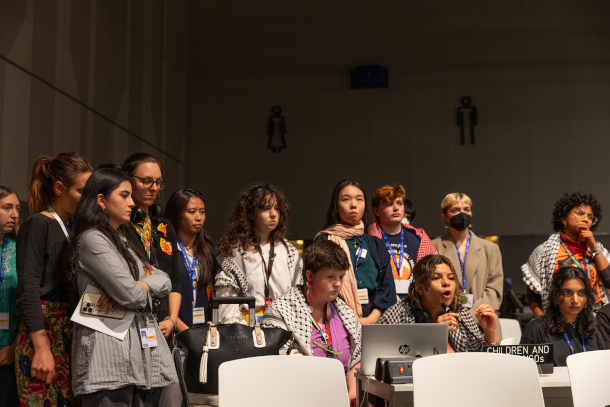
Youth representatives give a statement at the COP28 talks in Dubai. (Photo: Kiara Worth, COP28, UN Climate Change, Flickr, CC BY-NC-SA 2.0)
MEYER: Well, what gives me hope is the fact that despite all the tensions and the disagreements, countries were able to come to a consensus on a path forward here. It's not perfect, it's not as ambitious as I would have liked to see. But it definitely is a historic shift in these negotiations to say we have to come to grips with our addiction to fossil fuels. Now, that being said, the proof of the pudding is going to be in the next year or two, to see what countries actually do at home, what kind of commitments they put on the table, what impact this has on investors in the business community. But it was a real achievement. Another thing that gives me hope is the tremendous reductions that we see in the cost of the clean energy technologies that can replace fossil fuels, whether it's solar photovoltaic cells, wind turbines, electrolyzers, LED light bulbs, electric vehicles and batteries. I mean, just the force of those technology costs coming down is making tremendous shifts in the market. Not fast enough, not at the rate that we need, but it's accelerating. That gives me hope. And I would also say what gives me hope is the diversity of constituencies and voices coming into this process. When I started out in the run up to Rio in 1992, it was primarily the science community and some of the environmental movement that was driving this process. Now you have healthcare professionals, you have doctors, you have the faith community, you have labor unions, you have progressive business, you have indigenous people. And most importantly to me, you have the youth coming in and saying this is our future. You need to leave us an inhabitable planet. And so I think the fact that this has emerged as an issue that mobilizes all sectors of society to come in and demand action, gives me hope.
CURWOOD: Alden Myer is a senior associate at the climate change think tank, E3G. Alden, thanks so much for taking this time with us today.
MEYER: It was good to talk with you, Steve.
Related link:
E3G | ““The Fossil Fuel Era Is Ending” – E3G’s Reacts to COP28 Outcome”
[MUSIC: Trevor Hall, “Green Mountain State” on Chapter Of The Forest, Vanguard Records]
O’NEILL: Next time on the show, Native American tales that help explain why things in the universe are the way they are.
ROSS: It seemed that long, long ago, before there were people, winter came onto the land, and then never left. The sky was hidden with these big black clouds; it snowed all the time. This went on for about 3 years, and the animal people were freezing and starving, and so they all came together in a great council. And finally someone spoke up in council and they said you know, this must be hardest on our sister the bear. She has always hated the cold. And so they organized a search party to go in search of Bear. Now, Fox was chosen for his cunning, and Wolverine and Bobcat and Wolf for their fierceness and their strength. And those 4 were getting ready to walk out of the council when they heard a little voice speaking up. And they looked and it was the little Mouse. Well, the bigger, stronger animals didn't see how Mouse could be any help, but they decided she should go.
O’NEILL: Of course, it’s Mouse who has the winning strategy. To find out why tune in to the Living on Earth storytelling special next week.
[MUSIC: Beegie Adair, “Jingle Bells” on Christmas Jazz, Village Square]
CURWOOD: Living on Earth is produced by the World Media Foundation. Our crew includes Naomi Arenberg, Paloma Beltran, Josh Croom, Jenni Doering, Swayam Gagneja, Mattie Hibbs, Mazzi Ingram, Mark Kausch, Mark Seth Lender, Don Lyman, Sarah Mahaney, Sophia Pandelidis, Jake Rego, El Wilson, and Jolanda Omari. Special Thanks to NHPR—New Hampshire Public Radio.
O’NEILL: Tom Tiger engineered our show. Alison Lirish Dean composed our themes. You can hear us anytime at L-O-E dot org, Apple Podcasts and Google Podcasts, and like us, please, on our Facebook page - Living on Earth. We tweet from @livingonearth. And find us on Instagram at livingonearthradio. And you can write to us @ comments at loe dot org. I’m Aynsley O’Neill.
CURWOOD: And I’m Steve Curwood. Thanks for listening!
ANNOUNCER: Funding for Living on Earth comes from you, our listeners, and from the University of Massachusetts, Boston, in association with its School for the Environment, developing the next generation of environmental leaders. And from the Grantham Foundation for the protection of the environment, supporting strategic communications and collaboration in solving the world’s most pressing environmental problems.
ANNOUNCER 2: PRX.
Living on Earth wants to hear from you!
Living on Earth
62 Calef Highway, Suite 212
Lee, NH 03861
Telephone: 617-287-4121
E-mail: comments@loe.org
Newsletter [Click here]
Donate to Living on Earth!
Living on Earth is an independent media program and relies entirely on contributions from listeners and institutions supporting public service. Please donate now to preserve an independent environmental voice.
NewsletterLiving on Earth offers a weekly delivery of the show's rundown to your mailbox. Sign up for our newsletter today!
 Sailors For The Sea: Be the change you want to sea.
Sailors For The Sea: Be the change you want to sea.
 The Grantham Foundation for the Protection of the Environment: Committed to protecting and improving the health of the global environment.
The Grantham Foundation for the Protection of the Environment: Committed to protecting and improving the health of the global environment.
 Contribute to Living on Earth and receive, as our gift to you, an archival print of one of Mark Seth Lender's extraordinary wildlife photographs. Follow the link to see Mark's current collection of photographs.
Contribute to Living on Earth and receive, as our gift to you, an archival print of one of Mark Seth Lender's extraordinary wildlife photographs. Follow the link to see Mark's current collection of photographs.
 Buy a signed copy of Mark Seth Lender's book Smeagull the Seagull & support Living on Earth
Buy a signed copy of Mark Seth Lender's book Smeagull the Seagull & support Living on Earth

